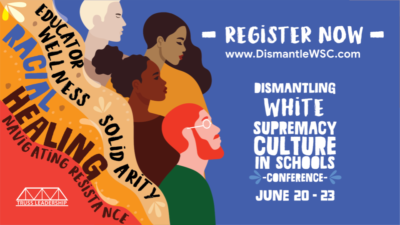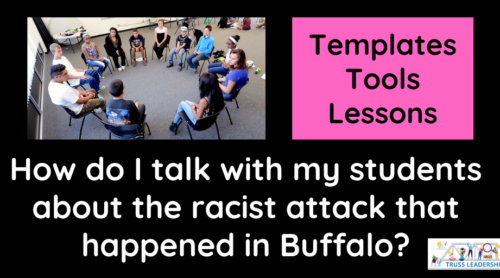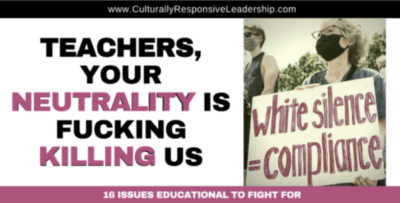How Do I Talk About What Happened in Buffalo With Students or Staff? – Processing Another White Supremacist Attack
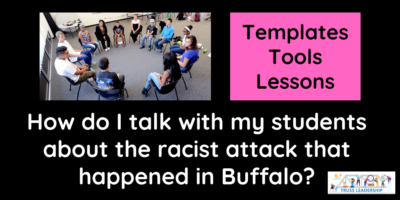
Kids will be in your classroom today. What will you say? Staff will be coming back to work today. How do I lead through this? No one tells you how to prepare for these moments and there is never enough training. We are still processing for ourselves but we must hold space for our students and staff. Silence is violence, but what do I say? What do I do?
SLOW DOWN Homie
Ok. Yes. This is a blog post about talking about the incident. And yes, I am partial to talking about current events and things that privileged folks tell us is “controversial”. But of course there are exceptions to talking about it. You don’t want to re-traumatize or re-harm students. Or BIPOC folks. This is a fine line of course, because you can do it in a humanizing way. It takes some preparation, trust, and support. Also, some students and staff don’t want to hear it. Maybe, especially from you. I don’t know your situation or relationship with your people. Also, some students might want to opt out, protect their peace, or process it in another way, on their own time. Respect that. Plan for alternatives and under some conditions, don’t talk about it at all, but talk with your people about where it can be brought up. Discuss and plan where students and staff can have access to discuss this.
But Should I Talk About This?
Yes. There is no time to be neutral and your silence is violence. If you are wondering whether or not you should say something, you should and if you need a nudge, read this blog post. It’s more of a swift kick in the ass. If you can get past the title and your own defensiveness, it will answer why you can’t just be silent and wait for this moment to pass. I literally got asked to not share it during trainings, because the title alone would offend people and cause hard. But you know what causes real harm? Murder. White supremacy. Racism. Systemic injustice. Not f-bombs and curse words. Not critical race theory (uh oh). Real harm is hard. So miss me with those white fragile emotions. Let’s get to work.
Here’s an excerpt from that blog post:
“Your neutrality is killing us. I’ll tell you why I’m mad. First things first. I ain’t talking to the teachers who support racism. Fuck them. They are probably reading another blog post, or lurking with no intention of changing their ways. Bye fragile Felicia. I am talking to those in the middle. Mr. “All I teach is content” and “I don’t bring politics into my classroom.” You. I’m talking to those who claim to be “colorblind,” who think “we talk too much about race anyway” and the teachers who say “all lives matter.” Hey, not-so-neutral centrists, your neutrality is fucking killing us. Slowly and quickly.

But What Do I Say? How Do I Prepare?
I was thinking about this question as I processed the horrific events in Buffalo New York. I started with some tweets and a thread.
We are literally being murdered by whites supremacists, but we are debating whether we CAN talk about being murdered by white supremacists. Or teach about a history of being murdered. Or systemic racism in the past and present. White folks, use your privilege.
— Truss Leadership – Joe Truss (@trussleadership) May 15, 2022
Then, I figured that I might be able to offer some ways to organize our thinking. Whether you get this the night before, during the early morning, on lunch, or at this summer’s conference, you might find something helpful in it. I always have appreciated templates and resources. I didn’t know what to say when I first started in education. I still stumble when I am talking through something new and raw. And when I was leader, I felt so much pressure to say the right thing. Examples go a long way. Instead of a sample response, I would direct you back to my controversial blog post where I shared how I thought about the many murders of 2020.
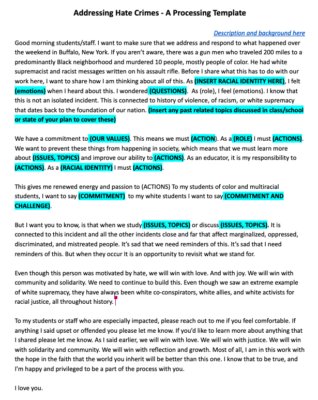 A Template to Process and Discuss
A Template to Process and Discuss
But take a look at this template, make a copy, fill in the blanks, and go from there. I know. You might not want a template and if you think you don’t maybe you don’t. Then again, maybe you do. It might help you organize your thoughts as you hold space for students. It might just help you with your process, even if you don’t say anything. Honestly, I’d love to see your thoughts as well, and you are welcome to share it with me. (trussleadership@gmail.com).
Hey. Let’s keep it 100. This ain’t right. Why do we have and need templates for this shit? Because something, lots of things are wrong with our society. The numbers don’t lie. But until we get it right, we need to address it.
Yes, This is for White People Too!
Ok, before we proceed, let’s address the elephant in the room. Is this just for Black and Brown folks? Yes and no. It is for their immediate benefit because we Black and Brown folks are under the boot of the system. We stay under that boot. We are being harmed, point blank killed, and are under attack. Therefore, creating space to address our concerns and life of death issues IS so very relevant. We are marginalized, so bringing us to the center is everything. Talking aint enough. We better be talking about change. Practice and policy. Dollars and cents too, but that’s another post, or book, or graduate degree.
Back to white folks.
Yes, it is for white folks too.
Who did the killing? Who has the political power in Amerika? Who has the master’s share of (stolen, exploited) wealth? Who made 2020 more than a Black people’s protest? Who can converge on an issue (look up interest convergence and cee-are-tee) and make political change happen? Who raises white children who bring skin privilege and tap into white supremacist systemic oppression? Who can swing between fragility, woke, ally, conspirator, and activist? Who can choose to see the water we are swimming in or claim ignorance? Who is learning how to be a law abiding and informed citizen up in your classrooms, TODAY? Who’s dominating our political, judicial, and legislative systems, way above their percentage of our population? Who could wake up and truly change things?
White people. And white people start off as white students.
So yes, it’s for the white students too.
So I Said The Thing, Now What Do I Do Next?
You never know what’s going to happen after. It’s like taking a leap of faith off a cliff. I can’t promise anything. Students might feel it, they might not. Depends on how much groundwork you have laid. Depends if they feel its performative or not (one way to combat this is to say, you haven’t been doing enough, own it). But students (or staff if you are a leader) might FEEL it, and appreciate it. It might be more of what you’ve been doing, centering the marginalized and creating the conditions for building empathy. It might be the thing that shows them that you are really bout that equity life, really reflective. Ok, but what next? Teach. Love. Connect. Discuss. There’s plenty of content that connects to this issue. Historical movements. Statistics in math. Social emotional skills. Stories of resistance. Sociological terms. Systemic racism and antiracist policies. So much. Just teach the students, not the content. Teach to the time.
Restorative Circles
Sharing how you feel and what you think is a good start. But it’s just the start. And that’s about you. You have to make space for your students, staff, or colleagues as well. You might use the structure of a restorative circle to process. Learn about restorative circles through the video here.
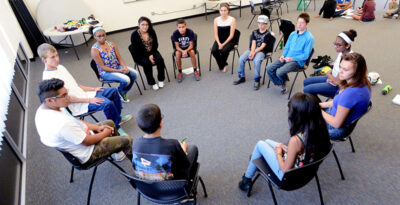
Other ideas could be found on the second page of the template, or in your head, or next door in your colleagues head. Or in your students heads. Discussions, readings, articles, projects, action research, you naaame it.
Honor the Victims
Center the victims of the killing spree. They are the story. Not the shooter. Yes, we must take a critical analysis of his actions, what they represent about our nation, and how to address it. But we cannot lose sight of those beautiful people who deserved to live.
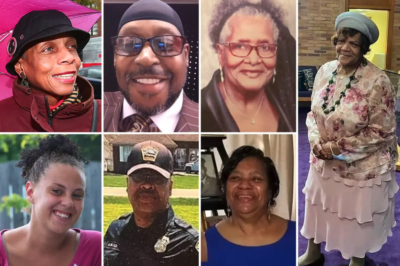
Need More Support?
- Get some. Be brave but be humble.
- Get a buddy, thought partner and critical friend.
- Read books, books, and more books
- Join groups, book clubs, and organizations
- Take trainings
- Come to our 3rd Annual Dismantling White Supremacy Culture in Schools Conference
